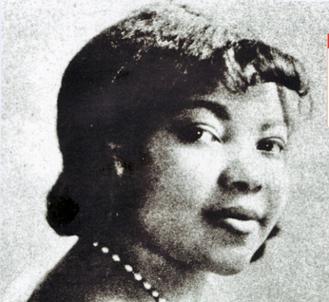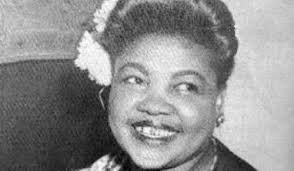Sippie Wallace – A Complete Biography
Introduction
Sippie Wallace (born Beulah Belle Thomas) was one of the defining female voices of classic blues. Billed as “The Texas Nightingale,” she wrote and sang songs that were witty, earthy, and unapologetically from a woman’s point of view, recording prolifically in the 1920s, stepping away to serve as a church musician for decades, and then enjoying a remarkable late-career revival that earned major awards and a new generation of fans. She stands alongside Ma Rainey, Bessie Smith, Ida Cox, and Alberta Hunter as a pillar of early blues history.

Childhood
Wallace’s exact birthplace is reported differently by reputable sources: some list Plum Bayou, Jefferson County, Arkansas, while others state Houston, Texas. What is not in dispute is that she grew up in a large, musical family that settled in Houston, where her father was a deacon at Shiloh Baptist Church and where she first learned piano and organ.
She was one of thirteen children; two brothers—George Washington Thomas and Hersal Thomas—became noted pianists and composers, and a niece, Hociel Thomas, also performed and recorded. The Thomases were steeped in church music, but the teenage Sippie and her siblings were equally drawn to the blues and ragtime they heard at traveling tent shows around Houston—an early duality (sacred and secular) that would shape Sippie’s life.
Youth
In 1915 Sippie moved with family to New Orleans, where her brothers were already active on the Gulf Coast jazz and blues circuit. Two years later she married Matt Wallace and took the surname by which she would be known on stage. By 1923 she followed her brothers to Chicago, entering the city’s bustling recording and club scene and quickly earning a contract with Okeh Records.
Between 1923 and 1927 she recorded more than 40 sides for Okeh, many written by her or in collaboration with George and Hersal. On those sessions she was accompanied by some of jazz’s brightest lights—Louis Armstrong, Sidney Bechet, King Oliver, Johnny Dodds, and Clarence Williams—evidence of the esteem she commanded among contemporaries. Early successes included “Shorty George,” “Up the Country Blues,” “Special Delivery Blues,” “Bedroom Blues,” and “I’m a Mighty Tight Woman.”
Tragedy struck when her prodigiously talented brother Hersal died in 1926 at just 19, an event that cast a shadow over her late-1920s output.
Adulthood
Wallace moved to Detroit in 1929. As the Depression throttled the classic-blues market, she stepped away from show business and, for roughly four decades, devoted herself to the church as an organist, singer, and choir director at Leland Baptist Church. She still performed occasionally, but her public career went quiet until the folk-blues revival of the 1960s.
Encouraged by her old friend Victoria Spivey, Wallace returned to the stage in 1966, touring on the folk and blues circuits and cutting new albums that reintroduced her signature material to new listeners. In 1970 she recorded with Spivey Records.
A powerful alliance with Bonnie Raitt—who had recorded “Women Be Wise” and “Mighty Tight Woman” on her 1971 debut—helped propel Wallace’s late-career renaissance. With Raitt’s support, Wallace recorded Sippie for Atlantic in 1982, backed by James Dapogny’s Chicago Jazz Band; the album won a W.C. Handy Award for Best Blues Album and earned a Grammy nomination. She performed widely, from Lincoln Center to European festivals, and appeared on television, including a 1982 Late Night with David Letterman performance with Raitt and Dr. John.
In recognition of her impact, Wallace was inducted posthumously into the Michigan Women’s Hall of Fame.
Major Compositions
Wallace was unusual among classic blues singers in that she wrote or co-wrote much of her repertoire, often with George or Hersal Thomas. Her songs combined sly humor, frank sensuality, and practical advice from a woman’s perspective. Representative works include:
- “Women Be Wise” — Her best-known anthem urging discretion in love; revived by Bonnie Raitt and a staple of Wallace’s comeback sets.
- “I’m a Mighty Tight Woman” — A swaggering declaration of autonomy and desire; one of her signature 1926 Okeh sides.
- “Special Delivery Blues” — A 1926 duet with Louis Armstrong that showcases her timing and comic bite.
- “Bedroom Blues,” “Shorty George,” “Up the Country Blues,” “Suitcase Blues,” “A Man for Every Day of the Week,” “The Flood Blues” — Cornerstone titles from her Okeh years.
Death
In March 1986, shortly after a concert at the Burghausen Jazz Festival in Germany, Wallace suffered a severe stroke. She returned to the United States and died in Detroit on November 1, 1986—her 88th birthday. Contemporary obituaries noted the arc of her two careers and her flamboyant stage presence. She was later interred at Trinity Cemetery in Detroit.
Conclusion
Sippie Wallace’s career bridged the classic-blues era and the late-20th-century revival. As a songwriter and performer, she voiced women’s desires and dilemmas with candor and humor, recorded with the greatest jazz musicians of her day, then returned in her sixties to claim overdue recognition, honors, and new audiences. Whether one accepts Houston or Arkansas as her birthplace, her cultural home is the canon of American blues, where her songs and persona continue to resonate.

Comments are closed